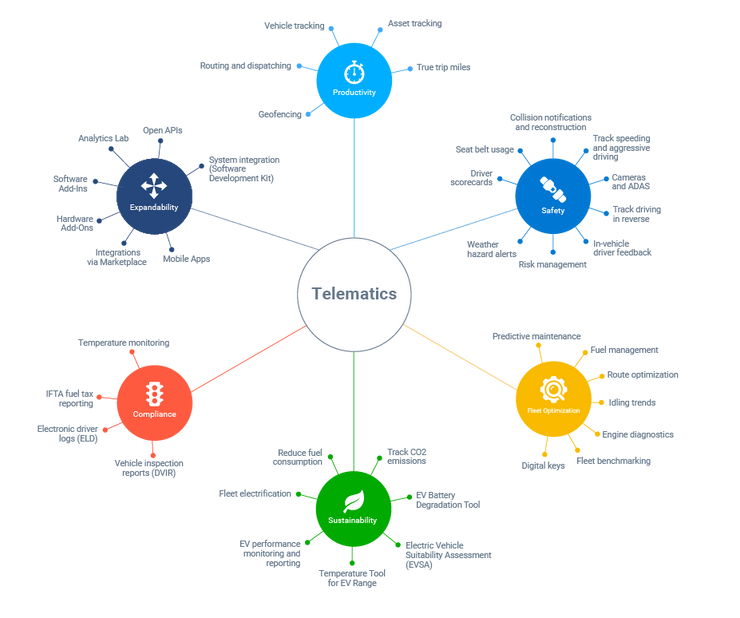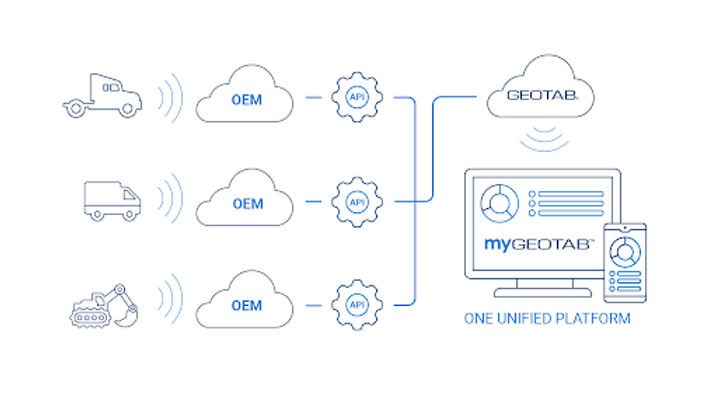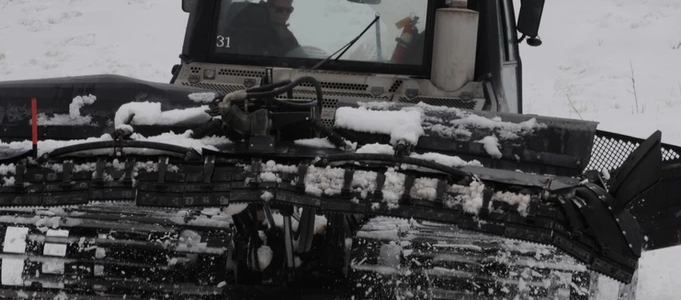What is Telematics?
In the automotive and fleet industry, telematics is typically synonymous with vehicle telematics fleet telematics or connected vehicles. Vehicle telematics is used to describe vehicle onboard communication services and applications that communicate with one another via GPS receivers and other telematics devices. In our experience, the most common application of this is vehicle asset tracking. This is achieved by combining a GPS system with onboard diagnostics, typically to map the exact location of a vehicle and the speed at which it is moving. Vehicle telematics continues to rise in popularity as a direct result of business demand and regulatory requirements. Fleets are relying on telematics data not only to remain compliant with the ELD mandate but to also run their operations more efficiently.
How telematics devices work?
The telematics device retrieves data generated by the vehicle, like GPS position, speed, engine light information and faults. G-force measured by a built-in accelerometer in the device. Then the telematics device sends the data up to the cloud.
A vast amount of data can be processed and analyzed with a telematics device and other connected hardware or sensors, such as:
-
Position
-
Vehicle speed
-
Trip distance/time
-
Idling time
-
Harsh braking and driving
-
Seat belt use
-
Fuel consumption
-
Vehicle faults
-
Battery voltage, and other engine data.
Finally, the data is decoded and brought into the fleet management software app for reporting and analysis. With the software, users can view and export reports and gain business intelligence such as the top 10 drivers with the highest number of speeding incidents or vehicles that are due for scheduled maintenance.
Data analytics and machine learning offer a way to get further use from telematics data. For example, fleets can use benchmarking to see how their fleet performs on safety as compared to other similar fleets or understand if routes are structured in the best way.

The benefits of vehicle telematics
Telematics assists in six core areas of fleet management: productivity, safety, fleet optimization, compliance, integration and sustainability.
-
Productivity — Improving customer service by using real-time GPS tracking, trip reporting, and dispatching and routing tools.
-
Safety — Increasing safety with in-vehicle driver coaching, risk and driver behavior reporting, collision notifications and reconstruction, and the ability to locate a stolen vehicle.
-
Fleet Optimization — Streamlining vehicle maintenance with predictive maintenance abilities and remote diagnostics, and fuel management by tracking idling and other fuel-guzzling habits.
-
Compliance — Electronic logging and Hours of Service, IFTA reporting, and vehicle inspections.
-
Integration — Combining other software systems with telematics such as onboard camera technology or CRM software, and even building new applications.
-
Sustainability — Reducing the fleet’s environmental impact and carbon emissions, plus managing electric vehicles.
In insurance telematics, vehicle owners share safety data with their insurance company to help lower the cost of premiums, if they can prove safe driving habits. Essentially, telematics can help insurance companies better pinpoint levels of risk. (While not all insurance agencies are offering this telematics-based insurance, it’s worth discussing with your provider if you’re not self-insured.)
Another area gaining in popularity is the ability to increase vehicle security by integrating identification sensors into vehicles. This allows fleets to authenticate a driver’s identity before they can start the vehicle.
Many types of companies use telematics, from small businesses to large corporations, not-for-profit organizations and government agencies. Allied Market Research values the global automotive telematics market at $50.4 billion in 2018 and estimates it will reach $320 billion by 2026.

Industries using telematics and fleet tracking (sample list):
-
Courier and delivery companies
-
Field sales and other services such as HVAC, plumbing, etc.
-
Towing companies
-
Trucking and transportation logistics
-
Construction businesses
-
Food and beverage companies
-
Transit fleets, such as motor coach, public transit, taxi and paratransit
-
Oil, gas, and mining industries
-
Utilities
-
Police, first responders, and other public agencies
-
Landscaping
-
Waste management fleets
-
Car rental and leasing companies
The future of telematics technology
The rise of telematics in the automotive industry has been a huge turning point for fleet efficiency and safety. As it continues to gain momentum, there are a few emerging trends to keep an eye on in the near future. Data sits at the heart of telematics, but understanding that data and acting on it can be challenging. Expect to see telematics providers, like GEOTAB, present customers with intelligent tools to help weed through raw data. GPS tracking systems will continue to become better integrated with other operational systems and will continue to improve while M2M technology expands. The emergence of the Internet of Things (IoT), smart home and smart city technologies are great examples of the rapid evolution happening in this space.
Looking for a vehicle telematics solution?
Advantage Asset Tracking is a Geotab Authorized Reseller that helps with safety, compliance, efficiency and so much more. With GPS tracking for vehicles and assets, ELD compliance, and more, we have a complete telematics system that helps create a unified fleet management system. If you’re looking for fleet management software, reach out to us for a demo or free trial today.
Get your Public Works fleet ready for winter operations before the first frost
Winter operations is probably the last thing on your mind right now but taking the time to get ready before the first evidence of winter’s chilly bite will allow you to thoroughly prepare before the arrival of ice and snow.
The first step in winter commissioning is obvious. Vehicles and equipment should be inspected and any routine or emergent maintenance scheduled and completed to make sure vehicles have maximum uptime, particularly if equipment (e.g., hydraulics, spreaders, blades, etc.) needs to be reinstalled.
For data-driven agencies, there is an equally crucial step that needs to be taken during this summer winter commissioning process: making sure you will have access to all of the metrics and measurements agencies rely on during mission critical events.
Winter operations as a data operation
With a comprehensive Public Works telematics solution, you will be able to collect critical data from spreader controllers, plow sensors and temperature sensors during the winter months. To guarantee that you are getting the right data from each of your vehicles, there are a few key steps you need to take.
Start by inspecting all of your rolling assets to make sure that the data you’re receiving is accurate. As part of this process, you’ll need to:
-
Calibrate the spreader controllers
-
Ensure the spreader is working with no errors or feedback sensor failure
-
Validate spreader controller material settings
-
Order spare GPS/AVL equipment if on-the-fly swaps are needed, especially if multiple drivers are using the vehicles
Partner with your telematics provider
As part of your telematics winter commissioning, you should work directly with us to verify that all of your hardware and software is working properly, including:
-
Making sure that firmware is updated and standardized based on material settings, confirming that your fleet will collect the data you need
-
Perform on-site GPS/AVL equipment inspections, replacing any defective equipment if spares are available
-
Confirm spreader, telemetry and temperature data communication
-
Verify winter operations reporting
With this comprehensive preparation, you will remove any guesswork from your decision making, and allow you to meet the worst winter storm event head on with the knowledge that you are receiving accurate, actionable real-time data.
While focusing on winter preparation during the heat of the summer may seem excessive at first, the results – accuracy, efficiency, productivity and no loss of critical operational data – can’t be beat.
Embedded Telematics: A Response to the Semiconductor Shortage?
The trend among leading vehicle manufacturers — or Original Equipment Manufacturers (OEMs) — to embed telematics devices directly into new vehicle models has been in the works for some time, but now it seems to have increased in momentum given the recent semiconductor shortage. But what exactly are embedded telematics? Simply stated, it is the technology that allows connected vehicles to send and receive data to and from the internet and other internet-connected devices.
Embedded Telematics Today and in The Future
Embedded devices can process OEM-specific vehicle information and telematics data once the consumer has given consent to the manufacturer. This data can then be integrated with an online fleet management platform that standardizes the user experience, enabling owners of fleets with a variety of vehicle and connectivity types to see all vehicle information in one place.
Because the sensors and capabilities are integrated directly into the vehicle, OEM solutions deliver a high degree of data accuracy and detection of vehicle health events during vehicle operation. This provides a desirable option for end users without the need to install additional hardware. It also provides access to information not always available in aftermarket options like true odometer readings.
The growth of the global embedded telematics market is driven by an increase in road accidents and vehicle mishaps. The continuous rise of vehicles on the road has created a need to maintain high safety standards, which further fuels the market growth. Moreover, a surge in demand for fleet management solutions in the logistics sector, regulatory mandates to improve vehicle and passenger safety, and the lingering semiconductor shortage have further propelled the growth of the market.
Overview of the Geotab OEM Data Platform
Geotab’s OEM platform provides the capability to integrate telematics data from the manufacturer and make it available on MyGeotab.

In a way, the Geotab OEM Data Platform leverages the building blocks available to all our integration partners. The functionality is available for partners to send telematics data from their devices via Geotab APIs defined in the SDK.
The OEM platform goes a step further by developing the integration capability internally. This not only standardizes the user experience but relieves the partner from spending effort to build and maintain the integration software. The platform is hosted by Geotab within a secured, highly available production environment which undergoes regular maintenance release cycles. This ensures that a high quality and reliable service is available to our users, so they can focus on what matters most to them — managing safe, productive and efficient fleet operations.
Value for Fleets
The solution provides distinct value to fleets which already have vehicles or construction equipment with embedded telematics devices. Some of the key benefits are highlighted below.
Benefits of using an OEM Data Platform:
-
Cost advantage — No device hardware or installation costs
-
Ease of use — Use the same MyGeotab portal and UI for tracking. Use the existing database to view devices from several pre-integrated OEMs alongside GO devices.
-
Faster time to market — No delays related to device shipment or installation.
-
Access to additional data — OEM and sensor data is sent directly by the embedded OEM device such as tire pressure.
How Can You Use the Solution?
Give us a call today and one of our team members will discuss whether integration of the Geotab OEM Data Platform makes sense for your business.
Adding a Video Camera Solution to Your Fleet Gives You a Competitive Advantage: Here’s How
Incorporating video to your fleet management strategy has many benefits. Video camera solutions provide important real-world data for driver coaching and safety but choosing one may seem overwhelming. Here are five questions to ask, before you decide on which dashcam to buy.
1. What problem are we trying to solve?
This is the single most important question to ask, and is often overlooked. Consult your business partners or other members of your organization to uncover the issues that need action. Here are some of the common video telematics use categories that we see:
-
Driver risk management — Monitor, score and coach drivers to reduce crashes.
-
Collision evidence — Capture on-road events to protect the company against litigation.
-
Security recording — Use cameras to monitor the security of valuable cargo and confirm the safety and quality of customer service.
2. Who will use and manage the videos?
It’s worth taking the time to list all the people who will use the video telematics portal and the information that it provides. Who will see the data? What is their job? Will video increase or decrease their current workload?
Failing to map out all the potential users in advance has drawbacks such as having the system underutilized. As well, if managers are not looped in early on, they could be surprised or disappointed later if it turns out the system does not meet their expectation.
3. What operations will it need to integrate with and enhance?
Integration is key for efficiency, for any kind of software, and especially video. If you will use video cameras for first notice of loss (FNOL), you will probably want to link the system to your Claims Processing department or service. A driver risk management video workflow output will likely need to link into your HR system. If you want video to fulfill a security function, you probably need a way to share data with the group that handles incident and loss investigations.
Thinking about these linkages in advance will allow you time to research whether the solution is supported by APIs that can enable or even automate data flow between systems.
4. How will we measure success?
To measure your return on investment, there are a number of metrics you can track. Your ROI won’t always be dollars. There are so many key performance indicators (KPIs) for fleet video cameras. Here are a few ideas below of some possible data points.
Types of camera metrics:
-
Risk management (Number of collisions per million miles, Risk rating)
-
First notice of loss (Claims processing time, Number of at-fault claims)
-
Security (Repair costs, Complaints)
Defining your success metrics in advance will make your camera search easier. You can check each camera option to ensure it delivers the analytics you need to measure performance. As well, prepare a weekly or monthly report for stakeholders to foster buy-in and support for your camera goals.
5. What are our future goals?
The final step of preparation before purchasing is to think of the future. How will your fleet change in the next 1-2 years? How about in 5 years? Take note of any upcoming shifts in business operations, vehicles or staffing. These changes will impact what dashcam features you need. Even if you won’t use these features or reports now, it makes sense to invest in technology that will stay useful in the long run.
As well, plan for success. Once you have achieved your first objectives, what will be the next goal you want to set? As your partner when it comes to meeting your fleet management goals, we are here to address all your video camera solutions questions or concerns.
6 Ways Telematics can help you get your vehicles ready for winter easier
It may seem premature to begin thinking of winterizing your fleet months ahead of the winter season, but now is the perfect time to do so. There are multiple reasons to get a head start on this but one is so important that it alone should get you motivated to start the process today: a shortage of vehicle production due to the semiconductor chip shortage means replacing faulty plows and other vehicles will become a problem. In summary, you will need to maximize the fleet you currently have and that starts with proper maintenance.
We have compiled below six ways to winterize your vehicles now so they better serve you all through the upcoming winter:
Make sure your winter wipers are in prime condition
Winter wipers come with a rubber covering that keeps ice from collecting on the blades. Travelling with a bad set of wipers can be dangerous if the rubber has deteriorated or has become torn from sitting under the hot summer sun.
Switch to winter tires. In the winter, ice and sleet contribute to dangerous, slippery road conditions. Below 7 degrees Celsius, around 44.7 degrees Fahrenheit, regular tires (all-season or summer type) harden and begin to lose their traction on the road. The right set of tires can offer huge advantages in bad winter weather.
Monitor tire pressure. Tire pressure drops roughly 1-2 pounds for every 10 degrees Fahrenheit that the temperature lowers. On newer vehicles, an in-vehicle alert for low tire pressure will be visible to the driver; older vehicles require drivers to check tire pressure manually. Geotab data can easily offer tire pressure information through its fleet management solutions.
Vehicle batteries can behave differently in winter. Make sure your drivers don’t get stranded at any point without being able to turn on the heater by prioritizing battery health checks. A vehicle’s battery and charging system might work well during spring and summer, but in winter your vehicles need a little more “juice.” More power is needed to start your engine in the cold, and you also get less power from your battery.
Stay on top of regular servicing. Certain vehicle components have a higher risk of failure in the winter. Bad hoses, belts, water pumps and spark plugs can cause your drivers to become stranded on the side of the road. Implement regular, preventive maintenance servicing during the winter months with automation. A predictive maintenance system can help decrease downtime and costs, and minimize unforeseen component failure. By pre-scheduling maintenance before the change in seasons, you can help ready the fleet for harsh winter conditions. Learn more about proactive maintenance by giving us a call today.
Prevent on-road breakdowns with Electrical Systems Rating (ESR) in MyGeotab. The rating system measures the health of a vehicle’s electrical system on a scale from 0 to 100, with four status categories: good, fair, caution and poor. At Caution, the fleet should schedule maintenance for the vehicle; at Poor the battery is likely to fail. An added benefit to fleet managers is that they can avoid preventative battery replacements unless the ESR reaches the Caution level. Ratings are calculated daily for every vehicle in the fleet.
Ready to optimize your winter fleet? Let us show you how simple it is to use our web-based software and fleet tracking devices to manage your winter operations fleet.






